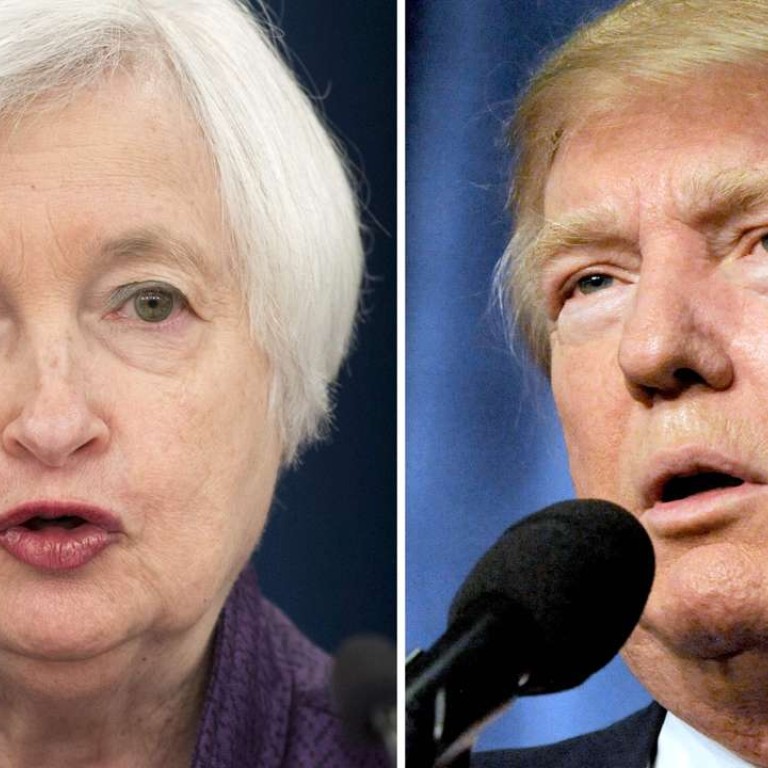
‘It’s a game-changer’: incoming US President Donald Trump poised to dramatically reshape Federal Reserve
Trump attacked Fed chairwoman during campaign, accusing her of keeping the benchmark rate “artificially low” to help Democrats
Donald Trump was highly critical of the Federal Reserve during the campaign. As president, he could get to quickly reshape it and the economic conditions that central bank policymakers will be facing.
Trump will have the opportunity to appoint as many as five new members to the seven-person Fed Board of Governors during his first year-and-a-half in office. That includes a replacement for Janet Yellen, whose term as chairwoman expires in early 2018.
Trump’s policies could create the circumstances that Fed policymakers have been awaiting to begin pushing rock-bottom interest rates closer to normal.
I think [Yellen] is very political and to a certain extent, I think she should be ashamed of herself
“From a pure monetary policy framework, this is probably the best news they could receive,” said Jack Ablin, chief investment officer of BMO Private Bank in Chicago.
For months, Yellen and her colleagues have been stuck in an uncomfortable position.
The Fed raised rates for the first time in nearly a decade in December 2015. Their plan was to start consistently raising their benchmark short-term interest rate, now just below 0.5 per cent, so it could be lowered again to boost economic activity when the next downturn comes. Yet Fed officials were not keen on additional increases with inflation stubbornly low because that risked hurting investment and growth.
“They’ve been holding off until they see signs of inflation and inflation expectations,” said John Cochrane, a senior fellow at the Hoover Institution at Stanford University.
Enter Trump, who has pledged large tax cuts and new federal tax credits to fuel a surge in private spending for roads, bridges, airports and other infrastructure. Pumping billions of dollars more into the economy will not only kick-start growth in the short run but also spur inflation.
Expectations of higher inflation in the wake of Trump’s election sent yields on 10-year Treasury notes sharply higher this week. Inflation has been creeping up in recent months but remains below the Fed’s preferred target of 2 per cent.
“I think his programme will start delivering the kind of growth that they have been seeking,” Judy Shelton, a member of Trump’s economic advisory council, said of Fed policymakers.
A big fiscal stimulus coming when the labour market is tight also would help boost workers wages, Ablin said.
Average hourly earnings have been rising gradually this year. And as prices of goods and services rise faster, workers may see wage growth accelerate.
“As long as wages keep up with inflation, the stock market forges higher and house prices continue to rise, the affect on consumers [from rising Fed rates] should be fairly minimal,” said Ryan Sweet, an analyst at Moody’s Analytics.

But that’s far from assured, Sweet said, and it’s hard to know how consumers might react to higher levels of inflation.
“We’ve been in an era of extremely low prices over several years, and consumers are extremely price sensitive,” he said, noting that people could change spending habits.
Higher inflation expectations also are likely to push the Fed policymakers to speed up their plans to raise interest rates over the next two to three years.
But the outlook is clouded by Trump’s trade policies. If he pursues the protectionist agenda that he championed as a candidate, such as large tariffs on Chinese and Mexican goods, that would push up prices of imports and further spur inflation.
“The uncertainty factor is huge,” said Diane Swonk of DS Economics in Chicago. “Higher tariffs would mean much more inflation but lower growth. It would put the Fed between a rock and a hard place in terms of how to deal with that.”
And it probably will be a much different Fed board grappling with those potential problems.
Trump hammered Yellen in the final months of the campaign, accusing her of keeping the benchmark rate “artificially low” to help fellow Democrats President Barack Obama and Hillary Clinton.
“I think she is very political and to a certain extent, I think she should be ashamed of herself,” Trump told CNBC in September.
Earlier in the campaign, Trump said he didn’t think that Yellen was doing a bad job. “I don’t know her but I have great respect for her,” Trump told The Wall Street Journal in May. “But I would imagine we would put a Republican in that position.”
Even if Yellen hangs on, Trump will have the unusual ability to dramatically transform the Fed early in his presidency. He immediately would get to fill two existing vacancies that are open because Senate Republicans blocked nominees Obama made last year. There has been speculation that Fed Governor Daniel Tarullo would step down early next year, creating a third opening.
Yellen’s term as chairwoman ends on February 3, 20108, and although she could stay on as a governor until 2024, former chairs rarely do that. Likewise, Stanley Fischer’s term as vice-chairman ends in June 2018 and he also probably would leave the Fed completely.
That would mean that by mid-2018 five of the seven Fed governors would be Trump appointees.
“It’s a game-changer,” Swonk said of the appointments Trump could make. “It would be a very different Fed.”

